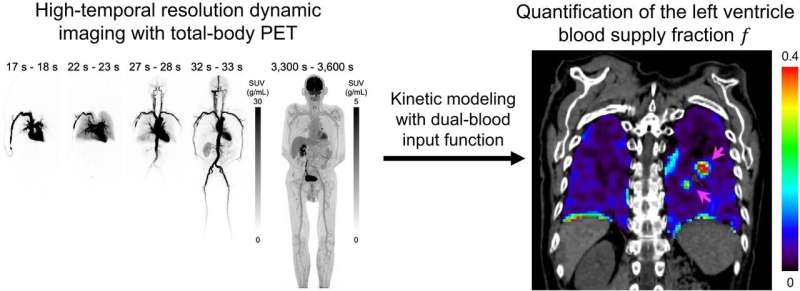This article has been reviewed according to Science X's editorial process and policies. Editors have highlighted the following attributes while ensuring the content's credibility:
fact-checked
peer-reviewed publication
trusted source
proofread
New scanner expands dynamic PET imaging ability to visualize dual blood supply in lung cancer

Lung cancer can advance quickly. Once a person starts treatment, it is vital to know whether that treatment is working or if the patient should be switched to a different treatment. New advanced imaging technology at UC Davis Health may give doctors a way to quickly track how well their patients are doing with a certain treatment.
Scientists at UC Davis Comprehensive Cancer and the UC Davis Department of Radiology have discovered a novel way to image the unique blood supply of the lungs. Their findings suggest it could help determine if lung cancer treatment is working.
The work is published in the Journal of Nuclear Medicine.
Pioneering EXPLORER gives scientists a peek inside the workings of the lungs
The research uses EXPLORER, an innovative PET scanner invented at UC Davis and housed at the UC Davis Health Molecular Imaging Center in Sacramento. EXPLORER provides images of the body in minutes with higher quality and less radiation than traditional positron emission tomography (PET) scanners.
The findings show for the first time how fast dynamic imaging using an advanced PET scanner, such as EXPLORER, can "see" into organs that have a dual blood supply. The lungs receive deoxygenated blood from the pulmonary arteries and oxygenated blood from the bronchial arteries.
Viewing the dual blood supply
Cancer frequently spreads to the lungs from other parts of the body because of this extensive blood supply.
"Our study found that the dual-blood supply effect is bigger in lung tumors than in normal lung tissue. This is why it can be used to spot lung cancer and has the potential to help us understand how it spreads," said Guobao Wang, a professor with the Department of Radiology, who is leading the study.
Insights from the study
Wang added that lung cancers often don't do well with treatments such as immunotherapy. Analyzing lung tumors with a powerful PET imaging tool may lead to better therapy.
"In this new work, we are combining high frame-rate movies from EXPLORER with advanced math to develop a new PET imaging method. This makes it now possible to see and understand the dual-blood supply in normal lung tissue and lung tumors," added Yiran Wang, a doctoral candidate in the Wang Lab and the first author of the research paper. He was jointly supervised by Simon Cherry, one of the co-inventors of the EXPLORER scanner.
More information: Yiran Wang et al, High-Temporal-Resolution Kinetic Modeling of Lung Tumors with Dual-Blood Input Function Using Total-Body Dynamic PET, Journal of Nuclear Medicine (2024). DOI: 10.2967/jnumed.123.267036


















